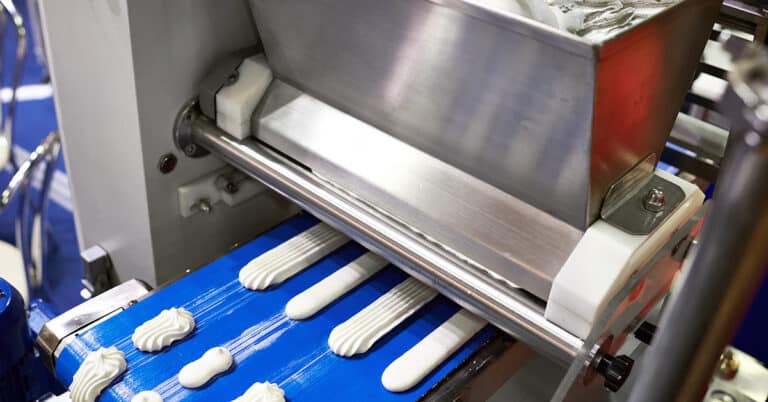Key performance indicators (KPIs) are measurements that can be used to understand process performance in your facility. It is critical to use and understand KPIs to set benchmarks, monitor and analyze performance, and help ensure that your manufacturing operation is running at optimal efficiency. Manufacturing KPIs may include production KPIs as well as inventory and fulfillment KPIs, quality KPIs, personnel KPIs, and more. In this blog, we will look at 20 manufacturing KPI examples and how you can use them to maximize performance and profit.
20 Manufacturing KPIs to drive optimization and success
The below manufacturing key performance indicators are just some of the examples of KPIs that you can use to maximize efficiency:
Overall equipment effectiveness (OEE): Arguably the best KPI for an overall snapshot of equipment and facility performance and efficiency. OEE is calculated by multiplying Performance (whether equipment is operating at the rated speed and output) X Quality (measuring the rate of defective or discarded parts against overall output) X Availability (the percentage of available scheduled time that equipment is operating, excluding scheduled maintenance or scheduled downtime).
Overall operating efficiency (OOE): Similar to OEE, except that the Availability metric in OOE includes all potential operating time (including scheduled maintenance and downtime). This KPI allows you to understand whether maintenance and other processes can be made more efficient.
Total effective equipment performance (TEEP): An even more stringent measure of efficiency, TEEP uses the same Performance X Quality X Availability formula, except in this case, Availability is measured against all potential available operating time (i.e., 24/7/365). This KPI allows you to examine all potential avenues for increasing value.
Uptime/downtime: Simply put, uptime is value-generating time, while downtime means that equipment is not providing value. The importance of these simple definitions means that these metrics should be closely tracked so that they can be focused upon and optimized.
Unscheduled downtime: Unscheduled downtime is the primary culprit of production inefficiency, and should be minimized as much as possible. Thus, unscheduled downtime should be closely tracked to provide as much data as possible to determine its cause.
Equipment capacity usage: Measures the potential output capacity for one machine, or for all equipment, against the actual output over a given period. This KPI provides data for decision-making on equipment purchasing, maintenance and usage. For example, high usage means that it may be prudent to expand capacity, while lower usage means that the facility might want to explore options such as selling equipment or leasing equipment time.
Cost per part: A useful snapshot benchmark that takes into account all resource costs that go into a production run (or production over a period), dividing production output by that figure. By benchmarking this KPI, the facility can identify efficiency trends and areas for potential improvement.
Maintenance costs: Over the lifetime of a piece of equipment, maintenance will often be the biggest cost associated with it. Thus, maintenance costs should be tracked as a KPI to measure efficiency and effectiveness. This KPI can also be used as evidence to support additional maintenance investments such as predictive maintenance infrastructure, which can reduce maintenance costs and improve efficiency over time.
Inventory turn: Inventory efficiency presents difficulty for many facilities and, as such, should be carefully tracked. The inventory turn KPI measures the average amount of time that a part stays on the storeroom shelf, and can greatly aid in improving ordering and procurement accuracy and efficiency.
Inventory accuracy: Inaccurate inventory can create major issues during maintenance as well as production runs. During maintenance, missing or misplaced parts can extend downtime and drive up costs. Inaccurate inventory prior to production runs can mean that a run is not completed as quickly as it could be. This negatively impacts OEE and OOE, as well as customer satisfaction measures discussed below.
First pass yield: A reasonably simple KPI that provides valuable high-level insight into the production process. First pass yield measures the percentage of parts that are produced correctly and accepted without additional work required. Since rework requires additional costs, this measure is key for the bottom line and can be used to identify potential maintenance and equipment performance issues.
Rework: As a component of first pass yield, rework involves additional machining or other processes to being a part into spec. This KPI is listed separately because of the immense time and cost impact that it may have on a production run, and thus should be independently tracked.
Scrap material: Scrap material is most frequently generated as a result of rework and discarded parts, and represents a pure waste of material investment. Scrap is also related to first pass yield, and is similarly listed separately here because of the often-unrecoverable resource waste that it creates.
Quality: One of the most important indicators of equipment performance and predictors of customer satisfaction, an overall “Quality” metric should be central to any KPI strategy. This KPI will comprise other quality KPIs in manufacturing such as first pass yield and other related metrics, and should be measured as a percentage against the quality standards that you have determined for your operations. This KPI can also be used as a motivating, goal-oriented factor for personnel.
Defect density: Most effectively used as a real-time KPI on a per-cycle or per-order basis, defect density tracks the percentage of defects in a given period. Defect density can be used to drive data-based diagnostics and decision-making regarding equipment adjustments or maintenance.
Return on asset investment: A useful KPI for purchasing decisions, this metric tracks the value of the output of a piece of equipment (or all machinery in the facility) against the cost of the equipment. It may also include maintenance costs, which can be lowered through investment in effective maintenance strategies and tactics.
On-time delivery: In conjunction with the Quality KPI, this is a primary measurement and predictor of customer satisfaction. By striving to keep this KPI as close to 100% as possible, you help ensure a customer-centric mindset that can reduce returns and boost repeat business.
Employee turnover: Happy employees are effective, productive employees. Unhappy employees can detract from productivity and, once they leave, create a burden on the business to recruit and hire to fill the open position. Aim to reduce these costs (and potential downtime and capacity reduction) by investing in employees and their satisfaction.
Safety incidents: Safety incidents detract from employee morale — creating a major negative impact on business and operations. These incidents typically require equipment shutdown, investigation, maintenance, etc. — as well as presenting safety risks. Focus on preventive and predictive maintenance to achieve a safety KPI goal of “zero incidents.”
Revenue/profit per employee: Another rough measurement that can provide a useful picture of the health of the business, the performance of personnel, and the productivity of operations. To determine this KPI, divide revenue or profit over a given period by the number of employees. Strive to maximize the metric by improving all other KPIs mentioned here.
ATS, a technology-driven leader in industrial maintenance and MRO asset management, stands ready to help you plan, track and measure manufacturing KPIs to determine the health and performance of your operations. We offer a vast array of services and maintenance technology, meant to implement enhancements, modernize your operations with a comprehensive maintenance strategy, provide a technical workforce, short term support or optimize asset management, and more. To learn about our full suite of services, contact ATS today.






